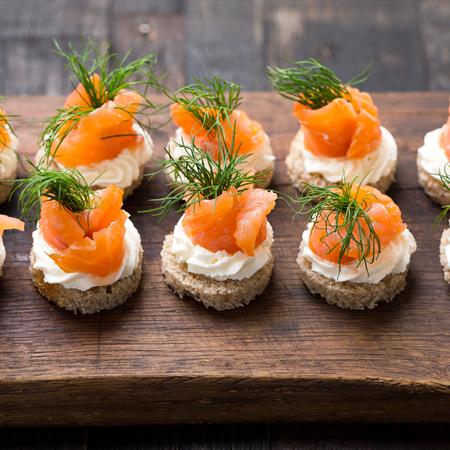Appetizer
 |
|
Whether served as starters or bite-sized entrées, appetizers should be as appealing to the eye as they are to the palate. |
Appetizers are those amazingly tasty tidbits that are served before a meal (as a starter), placed enticingly along a buffet table, or passed around on a tray as hors d’oeuvres. They may be exotic and colorful or meaty and filling. Depending on the occasion, whether elegant or casual, it’s always a good idea to make them easy to consume.
Varieties
Appetizers are grouped by whether they are served hot or cold. They can be mixed and matched and based on a theme, season, and ethnic region.
When planning your selection, choose varying textures, flavors, and colors for a greater variety and interesting display.
Buying Tips
• Purchase appetizer ingredients in phases or keep the pantry stocked with hard goods. Make a detailed list of what is on hand and what will need to bought immediately prior to an event.
• You can also combine personal recipes with goods purchased from a deli or favorite restaurant.
• Plan on purchasing a few garnishes as well, including cinnamon and fresh parsley. Use them, if needed, as last-minute “dress-ups” for a plain tray of food. For instance, cheesecake squares may benefit from a dusting of nutmeg, or a white dip could become more appetizing with a topping of chopped parsley leaves.
Planning Tips
The biggest fear in appetizer planning is running out of food. Use these general guidelines:
• For every five guests, plan on two different types of appetizers (1-5 guests = 2 varieties; 5-10 = 4 varieties, etc.).
• The time of day will factor into how many appetizers your guests will consume, but a good rule of thumb is eight pieces per hour per guest. This may be less if a meal is served and more if it is a festive or holiday occasion when people tend to overindulge. A younger crowd may also consume more.
Storage Tips
• Allow cooked foods to reach room temperature before refrigerating. For safety, cool quickly in a bed of ice. Still-warm foods placed in the fridge will encourage bacterial growth if an appropriate internal temperature is not reached in a short period.
• Do not pack refrigerator shelves tightly as this, too, will prevent cold from reaching the center goods.
Usage Tips
• Presentation is as important as the taste of each mouth-watering bite. If the food is intended as a starter, then the garnish, saucing, and plating are all-important. For a buffet setup, color and placement are critical. In this case, risers and cake stands can be put to practical use.
• Consider serving requirements. Cheese wedges that require cutting should have a stable surface. Stage plateaus for light foods that can be easily lifted. Traffic flow and the type of utensils used will also factor into design.





